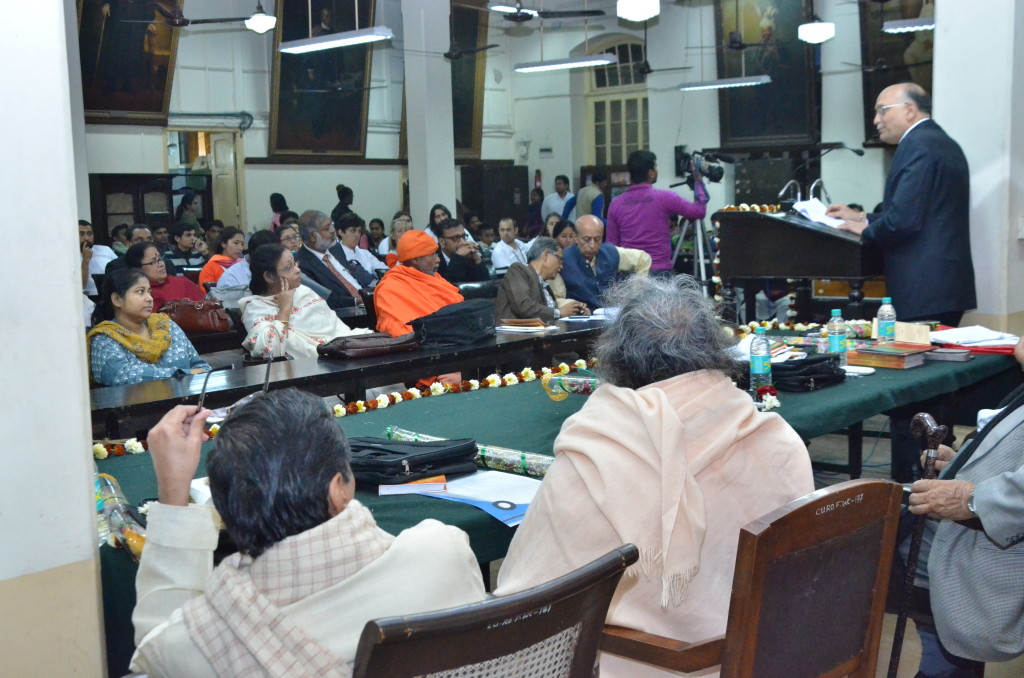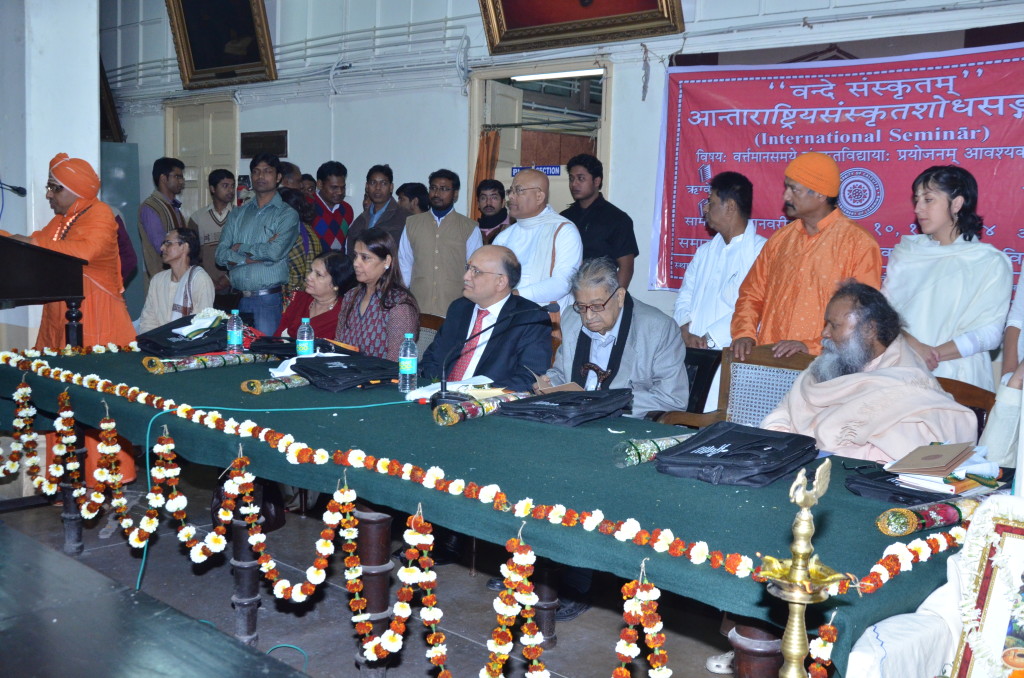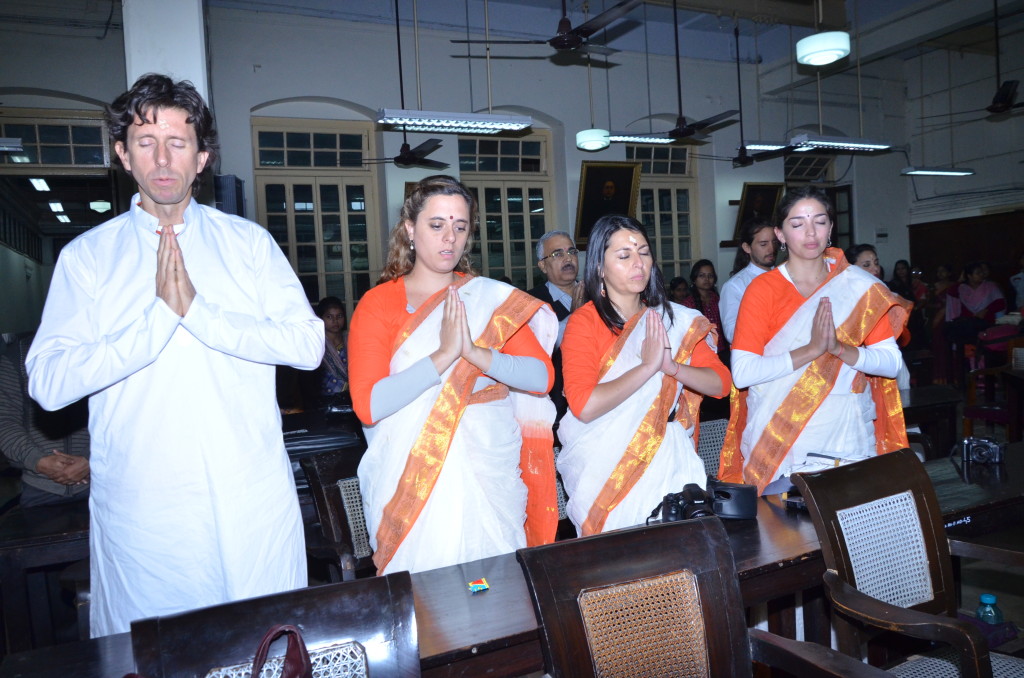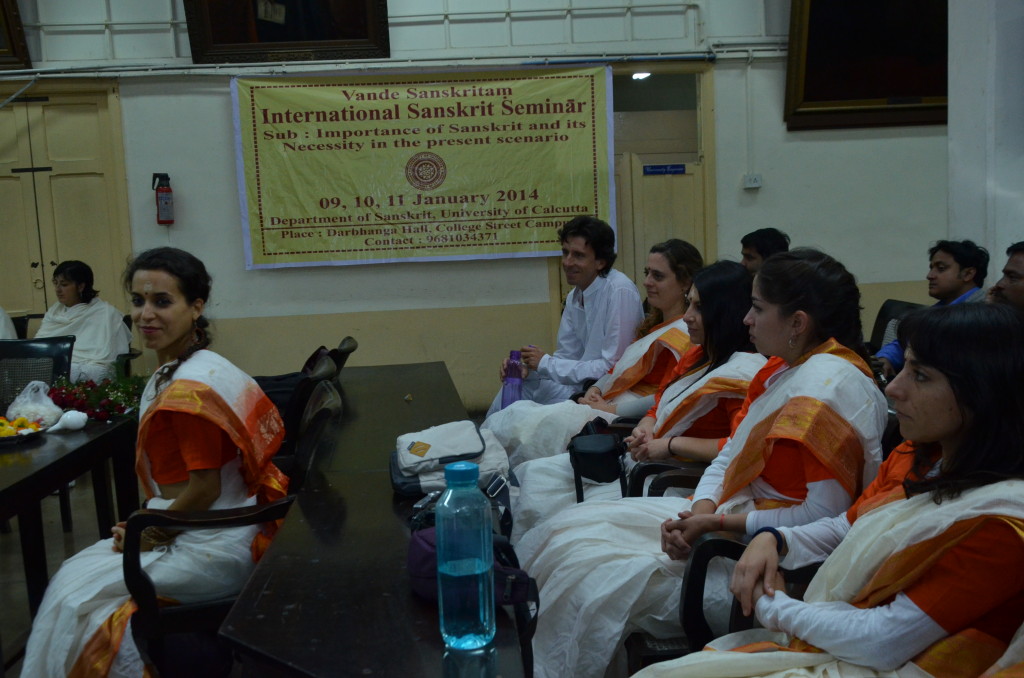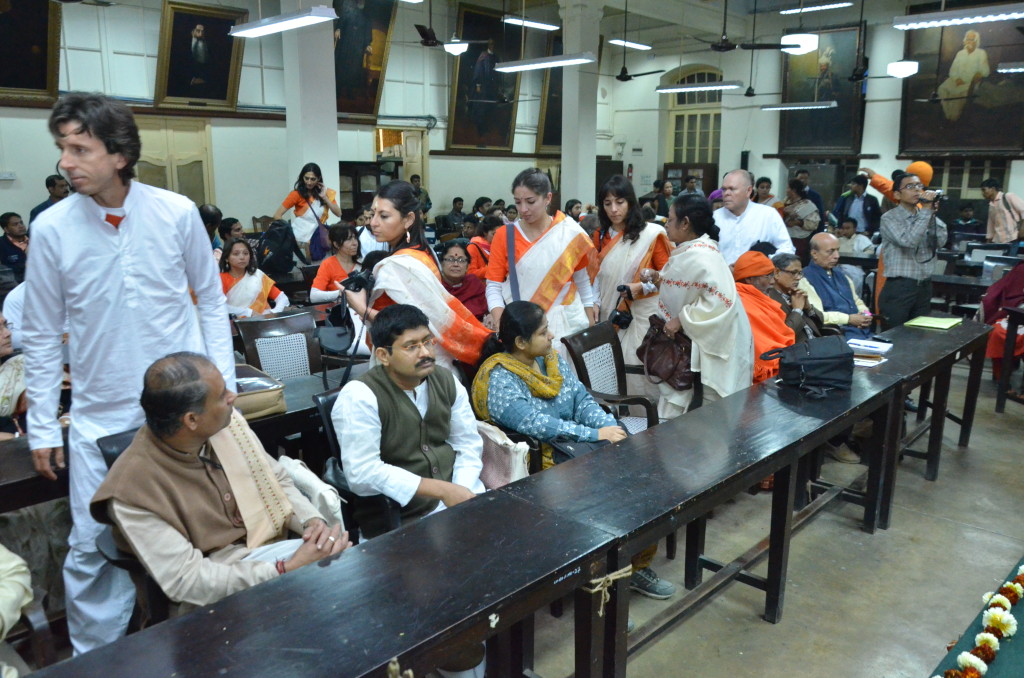 The Event: Three Day International Sanskrit Seminar
The Event: Three Day International Sanskrit Seminar
Organised by: Department of Sanskrit, University of Calcutta.
The Venue: Darbhanga Hall, College Street Campus, Calcutta 700073
The Guest of Honour: Pawan Kumar Ruia, Chairman, Ruia Group.
It was once the sacred playing field of Sir Asutosh Mukherjee, scholar extraordinary as his illustrious great-grandson, Retired Justice Chittatosh Mukherjee pointed out in his brief speech. Indeed, there could not have been a more sacred venue for the event, with Pandit Iswar Chandra Vidyasagar, Dr Sir Debiprasad Sarbadhikari, first Indian Vice Chancellor of the University, W C Bonerjea, Surendra Nath Banerjee, Netaji Subhash Chandra Bose and other luminaries of the letters looking down from larger than life portraits that adorn the walls of this historic hall, which has stood witness to successive generations of scholars in search of academic excellence.
Moderated by the Sanskrit scholar per excellence, Dr. Rabindra Nath Bhattacharyya, the Head of the Department of Sanskrit, University of Calcutta, the Inaugural Session’s mood was set by Hon. Suranjan Das, the Vice Chancellor of the University. Other speakers included Dhrubajyoti Chatterji Pro VC- Cal U, Prof Manu Lata Sharma of BHU, Janaki Nath Bramhachari,etc. The International event had participants coming from as far as Germany, Chile and Uruguay apart from Nepal and Bangladesh with almost all Universities of the Nation where Sanskrit is studied today being represented.
However, it was the irreplaceable Pawan Kumar Ruia, Chairman of the Ruia Group, who not only picked up the accolades of the distinguished members on the dais and the scholars in the audience with this thought provoking and dissecting deliberation but also created a rare example of Industry-Academia interface reaching a high that was yet un-scaled.
I am taking the liberty of appending the Speech in its entirety as it would not be prudent to work upon something that has been obviously strung together with a lot of effort – something that breathes the passion with which it was created with tender loving care for a language that we all eulogize only to allow it to gather the dust of our collective apathy.
“Dignitaries on the dais, ladies, gentlemen, friends,
It was indeed a pleasant surprise to receive the invitation for this seminar from the department of Sanskrit of the esteemed University of Calcutta. In an era when people only hear about discourses on science, technology, management, economics, politics, sociology and the kind, the moment one hears the term “Sanskrit”, the images that spontaneously pop up are those of religious activities. The very fact that a modern university like Calcutta is seriously working on giving Sanskrit its rightful place, a living, thriving and ever expanding language encompassing the knowledge of thousands of years, brought in an unexpected shower of happiness to me. By organizing this colloquium on Sanskrit, the most ancient and perfect among the great languages of the world, the department is doing a great service not only to the academia, but also to the Indian tradition and thought. I sincerely thank the department for organizing the seminar and also for inviting me here.
As is customary, let me begin by invoking the Blessings of Lord Ganesha:
अगजानन पद्मार्कं गजाननं अहर्निशम् ।
अनेकदंतं भक्तानां एकदन्तं उपास्महे ॥
(Agaja-[A]anana Padma-Arkam Gaja-[A]ananam Aharnisham |
Aneka-Dam-Tam Bhaktaanaam Eka-Dantam Upaasmahe ||
A few years ago, I was in a swank five star property where thought leaders from around the world and captains of our industry had gathered to deliberate on the emergence of India as an economic superpower. While most of what was being said was on predictable lines, I was taken aback by what one gentleman said. Listing out the reasons why he thought the “India story” was for real he told a baffled audience that according to the US space agency NASA, “Sanskrit is the most unambiguous of all human speech and best suited for Computer processing and artificial intelligence!”
Yes, it was baffling. Baffling because the predominant image associated with the learning of Sanskrit is that of a tol, a vernacular school, where little boys learn by the rote under the careful, loving guidance of a Pundit, the Guru. And this, the chosen medium of communication of computers? The language of artificial intelligence? That too, according to NASA the agency that was stretching the horizons of space and time?
The spellbound audience had broken into a spontaneous applause when the speech had ended. We were ecstatic having received the certificate from our so-called advanced western cousins. We nodded and looked at each other in obvious pride having learnt that Sanskrit – which comes to all our lives in our childhood as a choice of “third” language in secondary school – was being acknowledged, even lauded by the Americans.
Friends, such is our pride about our traditions and legacies and our virasaat that dates back to time immemorial that we look at others for not only acknowledgement but also certification. And Sanskrit is today reduced to Satya Meva Jayate which we do not believe in and Yada, yada hi darmasya, which is dusted out every time the Elections dawn upon us and we have to invoke the power of the Mahabharata in Television.
Sanskrit today is listed as one of the 22 Scheduled 22 language of India and is an official language of the state of Uttarakhand. According to the Census of 2001, only 14, 135 people listed Sanskrit as their Mother Tongue. Yes, less than 15,000 out of a population that is today about 1.27 billion list Sanskrit as their Mother Tongue. Before coming here, I had tried to access the figures as per the 2011 Census, but alas, they are not even listed. And my friends, here is the two biggest threats facing our existence in general and Sanskrit in particular – ignorance and indifference.
Sanskrit is included in the Eighth Schedule. For the uninitiated, in simple words, the inclusion in the Eighth Schedule means that the Government of India is under an obligation to take measures for the development of these languages, such that “they grow rapidly in richness and become effective means of communicating modern knowledge.” In addition, a candidate appearing in an examination conducted for public service at a higher level is entitled to use any of these languages as the medium in which he or she answers the paper. Let me not waste your time by elaborating on these exalted aims of the Government. Suffice to say, in whatever language written, they are meaningless to the blind and the illiterate.
It is indeed a matter of shame, not only for all of us present here today, but also for self respecting Indians everywhere, that in October 2012 noted social activist Hemant Goswami had to file a writ petition in the Punjab and Haryana High Court for declaring Sanskrit as a ‘minority’ language, so that it could enjoy special protection as available to minorities under the Constitution of India.
Not something to be proud of. Certainly not, if one were to consider the fact that Sanskrit was considered as Dev Bhasha, Devavani or the language of the Gods. Sanskrit is the oldest and the most systematic language in the world. The vastness and the versatility, and power of expression can be appreciated by the fact that this language has 65 words to describe various forms of earth, 67 words for water, and over 250 words to describe rainfall.
The fact that the same language is used for computations (Vedic Mathematics, Astronomy among others), Music (Gandharv Veda), Medicine (Ayurveda), Programming, Literature, Logic (Darshan Sashtra), Formulas (Sulabh Sutra), Politics and Economics (Arth Sashtra), Warfare (Dhanur Veda), Atomic Theory (Vaisheshik Darshan) without using any extra symbols and diagrams make it not only truly amazing but also incredible to modern day linguists who are just about beginning to comprehend the true nature and efficacy of the language.
The Sanskrit grammarians wished to construct a perfect language, which would belong to no one and thus belong to all, which would not develop but remain an ideal instrument of communication and culture for all peoples and all time. It is to us, that the ignominy of forcing this Mother of all languages to oblivion goes. May our tribe, increase.
Friends, it will not be out of place to mention here that the pre-Classical form of Sanskrit, which is known as Vedic Sanskrit, and is the language of the Rigveda is the oldest and most ancient language preserved, its oldest core dating back to as early as 1500 BCE. This makes Rigvedic Sanskrit one of the oldest attestations of any Indo-Iranian language, and one of the earliest attested members of the Indo-European languages, the family which includes English and most European languages. Forget about the Americans, even your European languages traces their origin back to the Mother. The Mother, who is today weeping because of our complete disregard.
It is said that when the ocean of milk was churned, among the many things that it gave us was the wish fulfilling cow, the Kamdhenu, the desire manifesting tree the Kalpavriksha-Parijata, the dream realizing gem – Chintamani-Kaustubha, the pot of plenty – Akshaya-Patra … Friends, all these were, in other words Sanskrit for it not only helped fulfill all our wishes, dreams and desires, it was also in the truest sense of the term, a cornucopia of endless treasures as the medium of expression. It helped mankind give concrete shape to its imagination and through it seek divine intervention in its quest for eternity.
Today, in our mad haste to banish Lakshmi and Saraswati from our lives, in our haste to embrace ignorance and ape the tinsel, we have forsaken the Amrit of life and are willingly, knowingly imbibing the Halahala – the Cosmic Poison of damnation.
I salute the efforts of the Sanskrit department of the Calcutta University once again for organizing this international seminar. Let me conclude by quoting Sir William Jones’ address of the year 1786 to the Royal Asiatic Society: “The Sanskrit language, whether, be its antiquity, is of wonderful structure, more perfect then Greek, more copious than the Latin and more refined then either.”
Thank you.”
You can Follow Pawan Ruia in Twitter: https://twitter.com/PawanRuia



